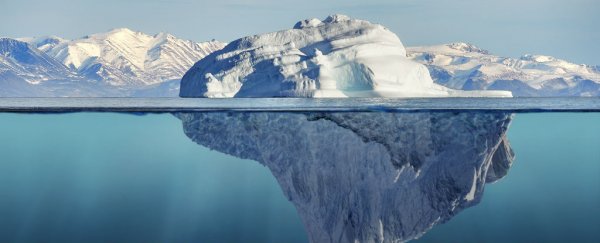Desperate times call for desperate measures, and it doesn't get more desperate than the Emirates Iceberg Project - a new plan to lug giant ice cubes halfway across the world to combat drought in the United Arab Emirates.
The project, which was announced last week by Abu Dhabi-based firm, the National Advisor Bureau Limited, involves dragging Antarctic icebergs more than 9,200 km (5,717 miles) across the Indian Ocean, and anchoring them to the Emirates coast as a source of drinking water.
"This is the purest water in the world," Sulaiman Al Shehi, managing director of Abu Dhabi-based National Advisor Bureau Limited, told Gulf News.
"We have formulated the technical and financial plan. Towing is the best method. We will start the project in the beginning of 2018."
If we can suspend disbelief for just a moment, here's the basic plan.
The average iceberg contains up to 20 billion gallons of fresh water - enough to quench the thirst of 1 million people for five years, the National Advisor Bureau Limited claims.
The iceberg would be dragged across the Indian Ocean to complete a year-long journey to Fujairah, an emirate on the east coast of the United Arab Emirates.
Computer simulations have indicated that the iceberg would lose about 30 percent of its total mass along the way, and once it's anchored at its destination, the company will fire up a water-processing operation that will see smaller blocks chipped off above the water line.
These blocks of polar ice will then be crushed into drinking water, which can be stored in large tanks for processing.
The project has been designed to address the fact that the United Arab Emirates is fast running out of drinking water, and desalination processes might not be enough.
Back in 2015, the Associated Press reported that the nation's groundwater could dry up in as little as 15 years, and cities are ravaging the environment (and their budgets) by relying on desalinated seawater to supply 98 percent of their drinking water.
And despite officials referring to water as "more important than oil" in the region, conservation doesn't appear to be much of a priority for many of the locals.
"A study … by the United Nations found that residents of the UAE and most of its Gulf neighbours use around 500 litres (132 gallons) of water per day - among some of the highest usage around the world," the Associated Press reports.
Al Shehi also admits that the spectacle will attract some sweet tourist dollars too, especially given the fact that his firm predicts that the iceberg will generate its own weather on the beach of Fujairah.
"It would create a vortex, which would draw clouds from all over the region," he claimed to Gulf News.
"[C]old air gushing out from an iceberg close to the shores of the Arabian Sea would cause a trough and rainstorms across the Arabian Gulf and the southern region of the Arabian Peninsula all year round."
"As the rising air expands, cools and condenses due to the decrease in air pressure … water vapour is collected in the clouds, they become heavy and falls as rain," he added.
While a massive block of ice sitting in the sun would have some effects on the immediate atmosphere, that claim of rain is a bit steep, says Weather.com meteorologist Linda Lam.
"Given the large difference between the temperature of the ice and the surrounding water, some local effects are possible, including cloud development around the iceberg," says Lam.
"However, given the complex interactions involved, including any impacts on the larger-scale weather pattern, it does not seem likely that rainstorms would be in the region all year long."
Will this project actually happen? ¯\_(ツ)_/¯
Al Shehi says that despite the scepticism from critics, his firm has already started mapping out the route. But it's not like they're the first group to attempt such a feat.
Back in the 1970s, French engineer Georges Mougin was commissioned by Saudi prince Mohammad al-Faisal to team up with a group of engineers and a polar explorer and launch a new project called the Iceberg Transport International.
"Faisal planned on wrapping a 100-million-ton iceberg in sailcloth and plastic and tugging it from the North Pole to the Red Sea, though the cost was estimated at an exorbitant $100 million," David Zax reported for Fast Company back in 2011.
"For a swank conference on 'iceberg utilisation', he even managed to ship, via helicopter, plane, and truck, a two-ton 'mini-berg' from Alaska to Iowa, where the giant block of ice was chipped apart to chill delegates' drinks."
So far so good, but things came to a grinding halt once those swanky delegates caught wind of the cost and actual feasibility of the project.
As of 2011, Mougin was still trying to formulate a plan that would actually work, and after more than three decades, it's not looking good. Do Al Shehi and his crew know something he doesn't?
If nothing else, the project could be a sign of things to come, as the situation on this rapidly warming planet becomes increasingly dire, and enterprising researchers and engineers look to 'big ideas' to solve our climate-related problems. Ten million wind-powered pumps blowing fresh water across the dwindling Arctic, anyone?
Oh and we should mention that we've been holding out on you a little, because the best part of the Emirates Iceberg Project is in this (Arabic-language) video by the National Advisor Bureau Limited.
PENGUINS AND POLAR BEARS (which don't even live in the same hemisphere) ARE STILL ON THE ICEBERG.

Let's all just move to Mars instead.
